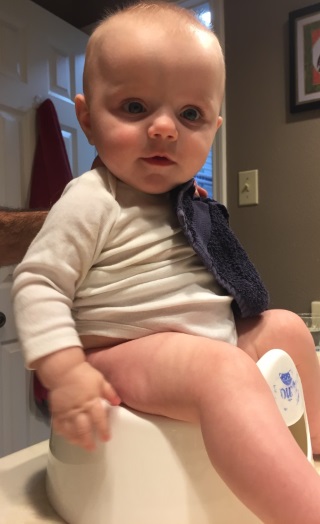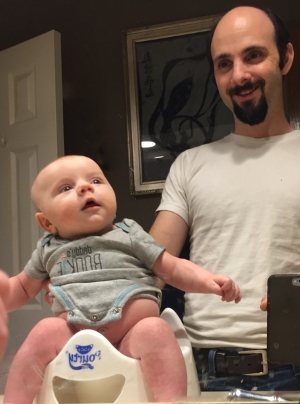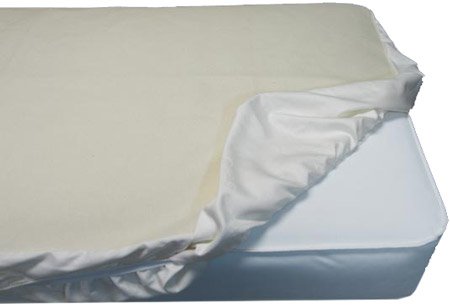Intro
I am a father of 3 children and I would like to share with you what I learned on my journey of infant potty training. Infant potty training is also known as elimination communication (or EC for short), and refers to various methods to setup routines and use cues in your child's behaviors to encourage toilet use instead of soiled diapers.
I created this site as a resource to help new parents get started with infant potty training. This is not a common practice in the US, and so I hope by sharing my story, I can encourage more parents to try to implement some level of infant potty training. I am a strong advocate because it can help you develop an early bond as you enable your child to take care of their needs, and helps the parents by reducing the dirty diapers around the house.
It was a different experience and process with each child as we learned more and refined our techniques. Here is what I've learned.

Why Start Now?
Your child prefers to poop and pee in a toilet.
My son started using the toilet when he was 7 days old. By supporting his thighs with my hands, and cradling his back in my arm, I would hold him over the adult toilet in my bathroom, giving him an opportunity. I was at first impressed that he would regularly pee when held over the toilet, in between diaper changes. But when he pooped in the toilet the first time, it became clear to me how powerful Elimination Communication would be.
My wife and I planned to introduce toilet training techniques with our newest son when he was 6 months old. We had done the same with our two daughters previously and had moderate success. Both had stopped wearing diapers during the day between two or two and a half. But with my first son, the fear getting peed on while changing the diaper encouraged me to look for a solution. Elimination Communication is about identifying patterns in behavior and building a toileting routine around them. The diaper change was already a cue for my son to relive himself, and proved to be an efficient routine as well.
The Benefits
- Use fewer diapers
- Better observe amount/quality of pee and poop
- Stop watching your child poop on themselves
- Touch less feces
- Share in the pride your child feels
- Less poop in the laundry
- Know you are doing your best to meet your child’s needs
How to Get Started

I know it was daunting to think about attempting infant potty training. When my wife first introduced me to EC with my oldest, it seemed impossible. But now that I have done it, looking back I think the steps are pretty simple. Spending time with an infant, you'll learn what it is they need when they are upset and fussy. For the brand new ones, usually you can calm a baby by fixing one of 3 problems:
- Hungry baby
- Has a dirty diaper
- Needs sleep
And you typically go in that order too. Well, with infant potty training, you add a new tool to the toolbox when it comes to solving this problem. First, get yourself a small plastic potty training toilet. If you are starting with brand new infant, the smaller the better.
Steps to Get Started
- Get yourself setup. Get a small toilet you can set in a comfortable place like the Pourty, a small plastic toilet I used on our bathroom counter.
- Each time you change your baby's diaper, try to set them on the toilet.
- Hold the baby on the the toilet, and make sounds to associate with toileting.
- I use a strong "Pssssss..." sound to imitate a peeing noise, and I do a lip vibration (motorboat noise maybe) to imitate a pooping noise.
- The point here is for baby to associate these noises with the toilet and be used in ongoing communication exercises.
- I also use our baby signs for "toilet" and "poop" as part of the holistic communication plan.
While there were only a few times where the children successfully used sign language to communicate about toileting, the routine is mostly about passing the time and distracting your baby while you give them an opportunity to use the toilet. Eventually, sometimes, pee or poop will come out, and you and baby can celebrate in your victory!
And sometimes you will have a dry toilet. And that's OK. Just keep listening to your child, and find the routine that works for both of you. When you have a hunch, put him on the toilet. Just do it, try it out. When you get success, it will keep you going.
My Techniques
Elimination communication is an art and like most artistic endeavours, you can improve your skills with experience. It is a mix of a regular routine to and developing a bond to help you intuit you child’s needs. It is also important that you take care of yourself and don't get stressed about the process. The goal is to provide opportunities for your child to you use the toilet and nothing more.
Provide your baby an opportunity to use the toilet when they:
- Wake up from a nap or in the morning.
- Seem uncomfortable or has a strained look in their face.
- Have not used the toilet for a while.
- Are crying and you don't think there is any other cause.
Success will be different for every family. Here are some techniques to get you started and help you determine what works best for you and your child.
My routine
Whenever you notice your child is going potty, recognize a cue, or just have a hunch, put them on the toilet calmly but quickly. You may not catch all or any, but this routine provides sanity on the quest for fewer diapers :-). Our typical routine is to put the baby on the toilet with every diaper change and stay there as long as he is happy. I make sounds to associate with using the toilet ("pssss" to represent peeing, and "pflmphhhh" to represent pooping.) I attempt a low humming noise intended to "open" up the baby's muscles and relax the poo and pee out. I exaggerate my mouth open and imagine I am able to create a note similar to the brown note.
Be Flexible
Introduce Infant potty training in a way that works for you. Within the EC world there is a spectrum of how it can be achieved. From diaper-less children to occasional toilet sessions. Even the smallest step to letting you child begin using the toilet starts to realize fewer diapers.
As with many things, the results will vary, and are likely to depend on how much effort you can make. Don't be too hard on yourself when things aren't working out, and just keep marching toward incremental improvements. The routine of helping your child use the toilet can be reward for parent and child alike.
Teach language
Talk to your child. We have always tried to talk with normal, adult-like, tone. Always use words correctly and entertain your little one with new words. Use them in complete sentences, speak slowly and clearly. We often talk about the toilet, using the words, “go pee-pee,” “do you have to go poop?” and, “using the toilet.” This helps associate words with the activity and will hopefully allow verbal communication about the toilet sooner.
Teach baby signs
With all three of our kids, we attempted to use sign language to help communicate before they could talk. Nothing complicated, but had a few go to signs to use for critical tasks like toileting, eating and sleeping. On the toilet, we worked on signs for, “toilet,” “poop,” “more,” and “all done.” We used signs similar to the official American Sign Language signs. These aren’t always easy for babies, and can be modified as needed. You can find video examples in the Related Info section.
Spend time
Yes, infant potty training takes time. With the right routine, the time will fly as it does with many aspects of parenting. Think of this as time you are spending with your child, which is important. The more you can, the better. Put your child first. You might find you drop everything when your baby needs something. Putting your child on the toilet is just one more way you can communicate that she is important.
Setup a toileting station
Find a place where you can keep all the things you need for infant potty training in a convenient place. Using your bathroom is a logical place. Keep easy access to the toilet for dumping your potty, and sinks for wiping everything down, including your baby.
Give massages
I don’t know any specific infant massage techniques, and I would recommend you learn more if you are interested. But a gentle back rubbing can help relax your baby and ensure they are comfortable to spend time on the toilet.
Be encouraging
Consider time on the toilet, a time to bond with your child. I fall back to saying things like, “you can do it,” or “you’re doing a good job.” I try to focus on encouraging the hard work entailed in learning new skills.
Distract you and baby
Since the more time you spend on the toilet, the more successful you will likely be, use some of the following ideas to keep you and your baby happy while using the toilet.
- Sing songs
- Make faces
- Listen to music
- Play with toys
Prepare for messes
Babies in general can be a messy endeavor. Toileting specifically can be even messier. Keep towels nearby so you can easily clean up any messes (over sprays, spit ups, etc.) to make your life easier.
Have a travel setup
It can be a daunting task to prepare to leave the house with your baby. Don’t get too hung up on preparing for toileting on the way out the door. For quick trips, you can bring a portable toilet seat, or just hold your child over the toilet. For longer trips, we bring the little toilet for the baby to sit on. This can be used in the parking lot of rest areas. You can use it on the side of the road too, but have to worry about how to dispose if baby goes poop. The Pottette Plus includes disposable plastic bags that can be used to catch the poop on the portal toilet seat. I never used this feature as we were always able to stop close enough to a bathroom.
Mindfulness
Being present with yourself is important for your own health. Take this time to practice mindfulness training techniques while you spend time with your little one for personal self improvement. While you may need modified techniques, take the time to zone out for a little and relax you mind. Work on achieving a meditative state which helps your baby be calm too.
More Related Information
Terminology
Elimination Communication
Elimination Communication (EC) is a practice in which a caregiver uses timing, signals, cues, and intuition to address an infant's need to eliminate waste. Caregivers try to recognize and respond to babies' bodily needs and enable them to urinate and defecate in an appropriate place (e.g. a toilet).
Dry-diaper-pee-pee-in-the-potty
Dry-diaper-pee-pee-in-the-potty is an often sought after event whereby you have managed to provide your baby a pott-ortunity before she wet the diaper, and then are successfull at convincing her to use the toilet. You may find this is not as common as you hope, so I encourage you to rejoice when this event does happen.
Source: The Poop Whisperer
Pott-ortunity
Pott-ortunity is the the cute name we use to talk about putting the baby on the toilet; the potty opportunity.
Source: The Poop Whisperer
Spadoodle
Spadoodle is a count sounding name I have used to describe a rather disgusting activity: baby spitting up. Spadoodles might be a little spit up, but they can range to more significant. I make sure to keep towels around while we are sitting on the toilet after feeding especially.
Source: The Poop Whisperer
Sign Language Videos
Toilet
Associate this sign with using the toilet and pay attention for your baby to make attempts to use a modified version. Make a fist and put your thumb between your index and middle finger. This is the ASL sign for the letter "T" and when you shake it back and forth, you have the sign for Toilet.
Poop
Signing poop can be another way to encourage your little one on the toilet. For this one, you are wrapping one hand around your thumb of your other hand and pull away.
More
The More sign is useful when toileting as well as other daily activities like when you child wants more food. To do this sign, you will touch your fingers to your thumbs on both hands and then tap your finger tips from each hand together. I use more to ask if he still needs to go, and we should wait on the toilet.
All Done
Signing all done helps communicate when your baby is done using the toilet. I typically use the "finished" sign to indicate this, when asking my children if they are all done on the toilet. All done can be used for a variety of needs, such as feeding too.
Recommended Products
The Pourty
The Pourty is a good choice to use as a small toilet for your child to sit on. I used this on our bathroom counter while holding my infant son. For the older kids, you can place this on the ground. Eventually they will be able to use it on their own! The Pourty gets its name because of the convenient pour spout on the back. You can use the built in handle to hold on to the front and pour your baby’s pee and poop directly into the toilet. This avoids contact with the sitting surfaces and is more hygienic. It makes me feel better when I only do a quick rinse after emptying.
Prince Lionheart Wee Pod Toilet Trainer
Prince Lionheart makes a nice toilet seat that goes on top of the normal toilet. This one is rather large which can seem bulky at times, but the extra material provides lots of low slip cushion for your child. This keeps the smaller ones from falling through. I would recommend this for soon after your child will be able to walk to use the toilet. This is the latest version of their seat. I had good experience with the Prince Lionhart weePod Basix.
